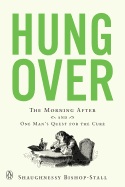
 Ever been curious about the science behind James Bond's strict policy on the preparation of his martini? Shaughnessy Bishop-Stall has answers: "A study published by the British Medical Journal concluded that shaking a martini is more effective in activating antioxidants and deactivating hydrogen peroxide than stirring one--supposedly lessening a double-O agent's chances of getting cataracts, cardiovascular disease and hangovers." This is the kind of factoid that populates Bishop-Stall's Hungover: The Morning After and One Man's Quest for the Cure.
Ever been curious about the science behind James Bond's strict policy on the preparation of his martini? Shaughnessy Bishop-Stall has answers: "A study published by the British Medical Journal concluded that shaking a martini is more effective in activating antioxidants and deactivating hydrogen peroxide than stirring one--supposedly lessening a double-O agent's chances of getting cataracts, cardiovascular disease and hangovers." This is the kind of factoid that populates Bishop-Stall's Hungover: The Morning After and One Man's Quest for the Cure.
Bishop-Stall is no stranger to immersive journalism. For Down to This, he spent a year living undercover in a tent city with Toronto's homeless community. For that effort, he earned nominations for the 2005 Pearson Writers' Trust of Canada Non-Fiction Prize and City of Toronto Book Award, among others. But with Hungover, Bishop-Stall immerses himself in a different kind of near-universal issue: how to deal with the dreaded "morning after."
Fans of Mary Roach will delight in Bishop-Stall's similar knack for collecting stories and anecdotes from a quirky cast of experts, as well as his similar proclivity for fascinating tangents. For a taste of his wit, see chapter titles like "The Hungover Games" or "I Woke Up This Morning." He also incorporates images such as Peter Paul Rubens's baroque painting Drunken Silenus and contemporary German street artist Dennis Schuster's depictions of a kater ("tomcat," aka "hangover").
Hungover is a world tour of a party, with a raucous cast of winos and experts, figures cultural and political: "Shakespearean actors have vomited on stage. Boris Yeltsin was found early in the morning outside the White House, in his underwear, trying to hail a cab to get some pizza." Trivia-ready tales abound, like that of an unlikely star of the first-ever Super Bowl: Green Bay Packer Max McGee became legend when he was unexpectedly called from the bench and led the team to a win--despite his legendary hangover.
As for "cures," some will be well-known, like aspirin: "What a kiss is to love, a shroud is to death and a childhood bedroom is to coming home, Aspirin is to the hangover." Others might be less so, like "squeezing the wedge of a lime in one's armpit."
Reading Hungover is akin to watching The Hangover, a film Bishop-Stall mentions often. His sense of adventure and one-liners make for a similarly uproarious ride. His exploits are, not surprisingly, funnier observed than experienced. Bishop-Stall spent the better part of a decade on Hungover, and it shows; the work is expansive, beautifully wrought, occasionally sensitive and, at times, unwieldy. Yet it works. It's long, but it's an engaging journey that comes with the option to take a sip and a break instead of jumping in all the way. It might most responsibly be enjoyed with a tall glass of water, but, more fittingly, a martini--shaken. --Katie Weed, freelance writer and reviewer
Shelf Talker: Shaughnessy Bishop-Stall dives deep into a sea of whiskey (and most other drinks), exploring different cultures' searches for what, if anything, can cure a hangover.

